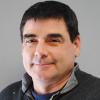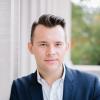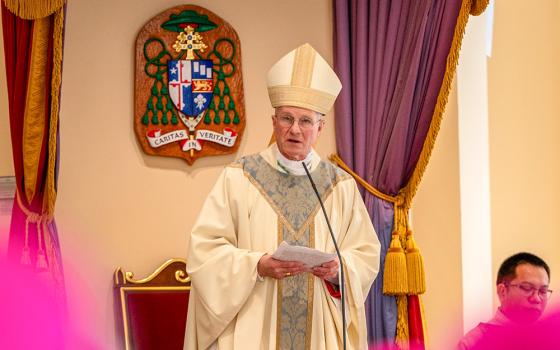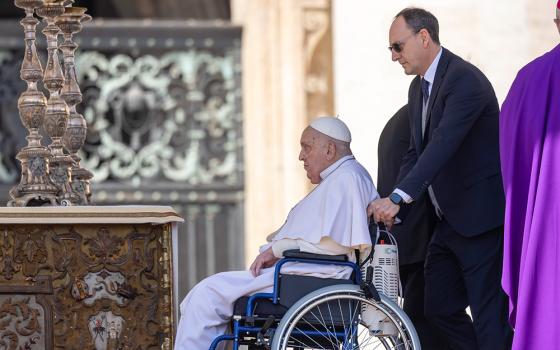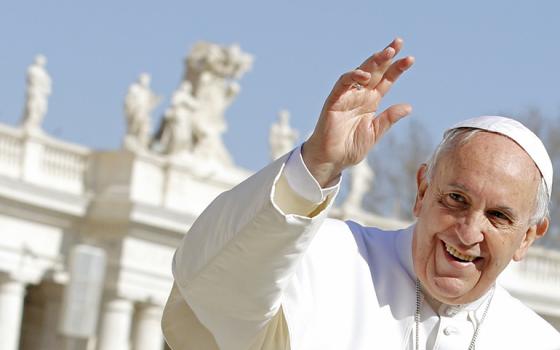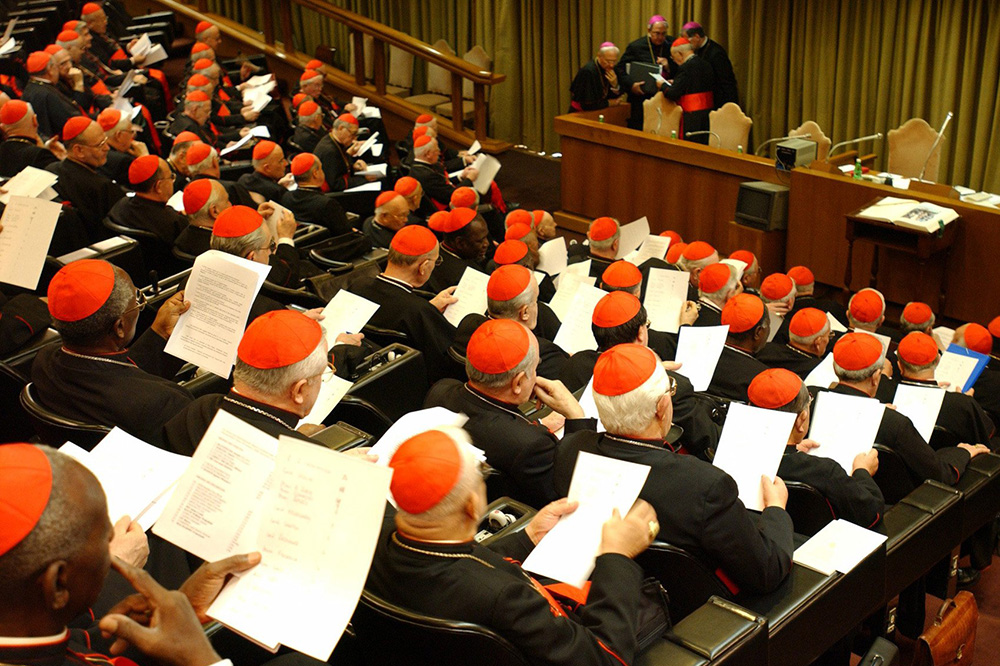
Cardinals gather in the Vatican's synod hall April 7, 2005, a day before the funeral of Pope John Paul II. (CNS/L'Osservatore Romano)
The pope is dead. In the next few weeks, the cardinals of the Catholic Church will gather in Rome to bury him and turn their minds and hearts to the selection of a successor. We do not know who will be selected in the conclave. But we do have a good idea of what will happen, and when, during this interregnum.
The last papal succession in 2013 was different because it did not follow the death of a pope, but the resignation of Pope Benedict XVI, the first pontiff to step down in nearly six centuries.
When Pope John Paul II died on April 2, 2005, the funeral was held six days later on April 8. In 1978, Pope Paul VI died on Aug. 6, and the funeral was also held six days afterward.
So, precedent suggests the funeral of Pope Francis likely will be in six days.
Presiding over the liturgy will be the dean of the College of Cardinals, Cardinal Giovanni Battista Re. Most of the world's cardinals and many bishops will come to Rome for the funeral.
Advertisement
Unlike most recent papal funerals, which concluded with the casket of the deceased pontiff being lowered into the crypt of St. Peter's, Francis will be buried at Santa Maria Maggiore, the patriarchal basilica atop the Esquiline Hill. Francis would go there to pray before and after his papal trips in front of the icon of the Virgin under the title "Salus Populi Romani" or "Salvation of the People of Rome."
Irish-born Cardinal Kevin Farrell, 77, who served as bishop of Dallas for a decade until 2017, is the camerlengo, the person charged with maintaining the basic functions of the Holy See during the sede vacante, meaning the period when the seat of Peter is empty. Employees will get paychecks, bills will be paid, and special stamps for the sede vacante will be sold.
In that role, Farrell is responsible for transforming the Sistine Chapel into a secure venue to host the conclave. He also must prepare the Domus Sanctae Marthae, the Vatican guesthouse, for the 135 cardinal-electors who will reside sequestered there during the conclave. Farrell is also tasked with electronic security, installing jamming devices to prevent eavesdropping on the proceedings.
And, of course, the chimney will be installed atop the roof of the Sistine Chapel whence the black or white smoke will indicate the results of the balloting. If no cardinal receives the two-thirds-plus-one votes needed to be elected pope, the ballots are burned with wet straw, and black smoke signals the negative result. When a pope is elected, the ballots are burned alone, producing white smoke. The cardinals use chemical additives now to make sure the smoke signal is obvious.
After the funeral, Re will formally invite the world's cardinals to gather for a series of general congregations to discuss the state and needs of the global church and what qualities might be sought in the next successor to St. Peter.
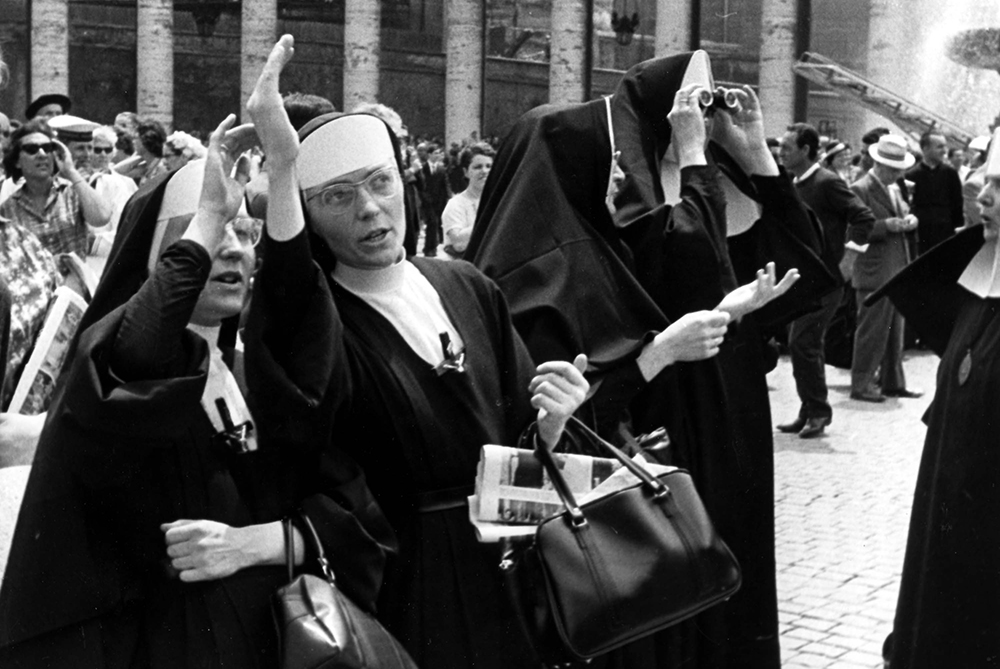
Roman Catholic nuns in St. Peter's Square stand watching smoke (unseen) coming from the chimney on roof of the Sistine Chapel June 20, 1963. (AP Photo)
In 2013, the formal invitation to the cardinals was sent on March 1, the day after Benedict's resignation took effect, and the meetings began on March 4. All the cardinals are invited to attend and speak at these general congregations — both those who are under the age of 80 and are therefore cardinal-electors, and those who are over 80, and thus will be ineligible to vote in the conclave to follow.
The general congregations will be presided over by 91-year-old Re as dean of the college. However, because Re is over 80, and only cardinal-electors are allowed in the conclave, the task of leading the College of Cardinals in the Sistine Chapel falls to the senior cardinal-bishop, Cardinal Fernando Filoni.
Once all the cardinal-electors are present, a date will be set for the commencement of the conclave.
In 2013, not all the electors arrived in Rome until March 7. There were 207 cardinals in total, of whom 117 were electors in 2013. Two cardinal electors declined to attend: Cardinal Julius Darmaatmadja from Jakarta, Indonesia, whose health prevented the journey, and Scotland's Cardinal Keith O'Brien, archbishop of St. Andrews and Edinburgh, who had been accused of sexual misconduct with priests and did not want to detract from the work of the conclave.
Currently, there are 252 cardinals in total of whom 135 are eligible to vote.
The cardinals will all take an oath to abide by the apostolic constitutions that govern papal elections, including a promise "to maintain rigorous secrecy" regarding everything that pertains to the election. This promise was not always honored in 2013.
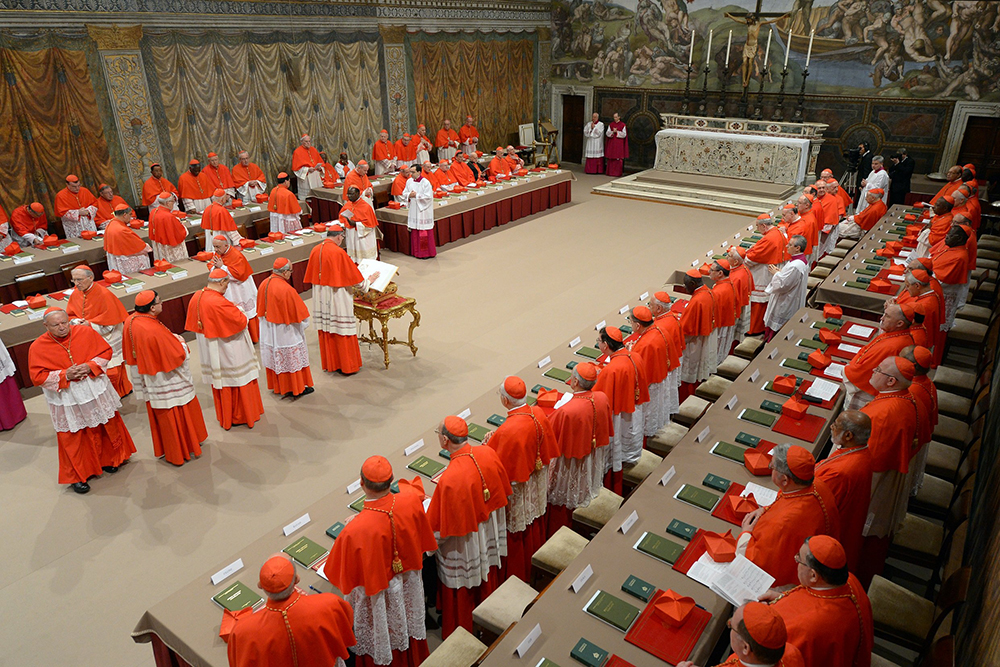
Cardinals enter the Sistine Chapel at the Vatican March 12, 2013, to elect a successor to Pope Benedict XVI. (CNS/Vatican Media)
Several resourceful Italian journalists learned and reported detailed accounts of what was being discussed behind closed doors, with Andrea Tornielli's accounts in La Stampa being among the most detailed. According to Gerard O'Connell's invaluable account of the conclave, The Election of Pope Francis: An Inside Account of the Conclave That Changed History, as the cardinals gathered March 6 for their third day of general congregations, one of the cardinals made a joke about the leaks to the journalist. In a loud voice, the cardinal cracked, "Is Cardinal Tornielli here today?"
Over the next week or so, the cardinals will gather for the general congregations twice a day, in the morning and the late afternoon, in the Synod Hall. This room is part of the Paul VI Audience Hall, Pier Luigi Nervi's modern architectural masterpiece along the south side of Vatican City. The Synod Hall is relatively small, with tiered seating facing a dais. In 2013, the cardinal bishops were seated in the front, with the cardinal priests behind them, and the cardinal deacons in the back. Within each group, they sit in order of precedence based on seniority, determined by the date of their elevation to the rank of cardinal. Simultaneous translation is provided via headphones.
During the general congregations, the cardinals are invited to speak about the needs of the church and the kind of pope they believe should be elected. These can become repetitive, and the interventions — as the speeches are called — are formal.
Still, every once in a while, someone says something that makes the other cardinals stop and take notice. According to O'Connell, at the 2013 general congregations, Brazilian Cardinal Odilo Scherer defended the curial cardinals who had been criticized in previous interventions, and doomed whatever chances of election he had.
We have the text of one of the interventions from 2013. The comments of Cardinal Jorge María Bergoglio of Buenos Aires, Argentina, so impressed Cardinal Jorge Ortega of Havana that he asked him for the text. Bergoglio was speaking from notes, not prepared remarks, but he wrote down the gist of what he had said for Ortega. After Bergoglio's election as pope, Ortega obtained his permission to publish what was then a historic document.
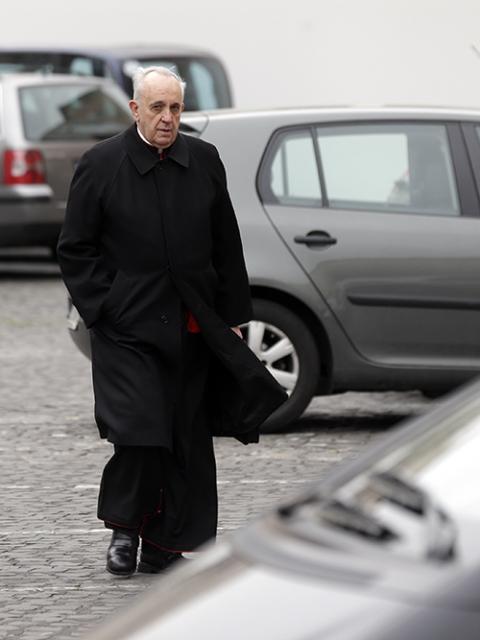
Cardinal Jorge Mario Bergoglio arrives for a meeting at the Vatican on March 6, 2013. Cardinals from around the world have gathered inside the Vatican for their first round of meetings before the conclave to elect the next pope, amid scandals inside and out of the Vatican and the continued reverberations of Benedict XVI's decision to retire. (AP Photo/Alessandra Tarantino)
The most famous section captured the mood of the cardinals, and many believe propelled him into the chair of St. Peter. Recalling the text from Revelations where Jesus stands at the door knocking, the future pope said:
Obviously, the text refers to his knocking at the door from the outside to enter — but I think about the times in which Jesus knocks from within so that we let him out. The self-referential church seeks to keep Jesus Christ within herself and does not let him out.
The insight captured in a profound way what the cardinals had been trying, and often failing, to identify as the crux of the problem: That the church had turned inward in the previous decades and needed to recover its outward-facing mission of evangelization.
In 2005, the conclave began on April 18, 10 days after the funeral of John Paul II. In 2013, the conclave began on March 12, 12 days after Benedict XVI's resignation took effect. The decision of when to commence the conclave will be decided by the cardinals meeting in general congregation.
The Sunday before the conclave begins, the cardinals say Mass at their titular churches. When a man is made a cardinal, he is assigned a church in Rome of which he is the titular pastor. It is in this capacity that he votes for the pope, preserving the symbolism that the clergy of Rome elect their bishop.
So, for example, Cardinal Donald Wuerl, the archbishop emeritus of Washington, is the cardinal priest of the Church of San Pietro in Vincoli (St. Peter in Chains) and Chicago's Cardinal Blase Cupich is the cardinal priest of San Bartolomeo in Isola (St. Bartholomew on the island).

Stoves used to burn ballots during a papal conclave are seen in the Vatican's Sistine Chapel March 8, 2013. (CNS/L'Osservatore Romano)
The media will flock to hear the sermons given by those cardinals deemed papabile — literally pope-able, or pope worthy, or those considered frontrunners.
On the day the conclave begins, the cardinal-electors will move into the Domus Sanctae Marthae. Late in the morning, the Mass for the Election of the Roman Pontiff will be held in St. Peter's, again presided over by Re.
After the Mass, the cardinal-electors retire to the Domus for lunch and are cut off from all communication with the outside world. That afternoon, they will head over to the Sistine Chapel and the voting will begin.
The cardinals who are over 80 and ineligible to vote will join the rest of us on the outside, waiting to find out who the new pope will be.
